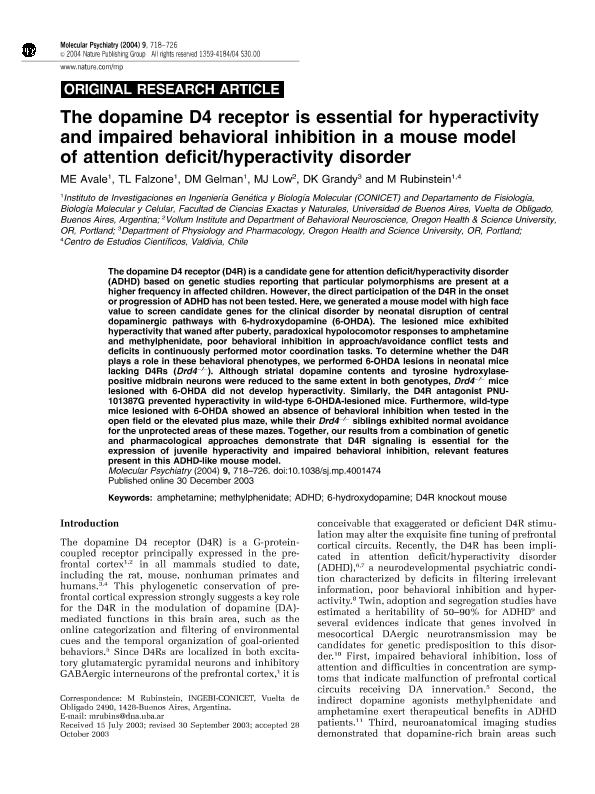Artículo
The dopamine D4 receptor is essential for hyperactivity and impaired behavioral inhibition in a mouse model of attention deficit/hyperactivity disorder
Avale, Maria Elena ; Falzone, Tomas Luis
; Falzone, Tomas Luis ; Gelman, Diego Matias
; Gelman, Diego Matias ; Low, Malcolm J.; Grandy, David K.; Rubinstein, Marcelo
; Low, Malcolm J.; Grandy, David K.; Rubinstein, Marcelo
 ; Falzone, Tomas Luis
; Falzone, Tomas Luis ; Gelman, Diego Matias
; Gelman, Diego Matias ; Low, Malcolm J.; Grandy, David K.; Rubinstein, Marcelo
; Low, Malcolm J.; Grandy, David K.; Rubinstein, Marcelo
Fecha de publicación:
07/2004
Editorial:
Nature Publishing Group
Revista:
Molecular Psychiatry
ISSN:
1359-4184
Idioma:
Inglés
Tipo de recurso:
Artículo publicado
Clasificación temática:
Resumen
The dopamine D4 receptor (D4R) is a candidate gene for attention deficit/hyperactivity disorder (ADHD) based on genetic studies reporting that particular polymorphisms are present at a higher frequency in affected children. However, the direct participation of the D4R in the onset or progression of ADHD has not been tested. Here, we generated a mouse model with high face value to screen candidate genes for the clinical disorder by neonatal disruption of central dopaminergic pathways with 6-hydroxydopamine (6-OHDA). The lesioned mice exhibited hyperactivity that waned after puberty, paradoxical hypolocomotor responses to amphetamine and methylphenidate, poor behavioral inhibition in approach/avoidance conflict tests and deficits in continuously performed motor coordination tasks. To determine whether the D4R plays a role in these behavioral phenotypes, we performed 6-OHDA lesions in neonatal mice lacking D4Rs (Drd4-/-). Although striatal dopamine contents and tyrosine hydroxylase-positive midbrain neurons were reduced to the same extent in both genotypes, Drd4-/- mice lesioned with 6-OHDA did not develop hyperactivity. Similarly, the D4R antagonist PNU-101387G prevented hyperactivity in wild-type 6-OHDA-lesioned mice. Furthermore, wild-type mice lesioned with 6-OHDA showed an absence of behavioral inhibition when tested in the open field or the elevated plus maze, while their Drd4-/- siblings exhibited normal avoidance for the unprotected areas of these mazes. Together, our results from a combination of genetic and pharmacological approaches demonstrate that D4R signaling is essential for the expression of juvenile hyperactivity and impaired behavioral inhibition, relevant features present in this ADHD-like mouse model.
Palabras clave:
6-Hydroxydopamine
,
Adhd
,
Amphetamine
,
D4r Knockout Mouse
,
Methylphenidate
Archivos asociados
Licencia
Identificadores
Colecciones
Articulos(INGEBI)
Articulos de INST.DE INVEST.EN ING.GENETICA Y BIOL.MOLECULAR "DR. HECTOR N TORRES"
Articulos de INST.DE INVEST.EN ING.GENETICA Y BIOL.MOLECULAR "DR. HECTOR N TORRES"
Citación
Avale, Maria Elena; Falzone, Tomas Luis; Gelman, Diego Matias; Low, Malcolm J.; Grandy, David K.; et al.; The dopamine D4 receptor is essential for hyperactivity and impaired behavioral inhibition in a mouse model of attention deficit/hyperactivity disorder; Nature Publishing Group; Molecular Psychiatry; 9; 7; 7-2004; 718-726
Compartir
Altmétricas



